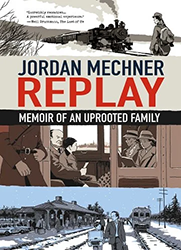Some of the most interesting graphic novels are memoirs, especially those that revolve around the writer’s troubled adolescence. The graphic format seems ideal for that kind of introspection or navel gazing. Teens flock to stories about everyday heroes who emerge from the depths of loneliness and social isolation. Adults are equally drawn to tales that make their own traumatic adolescent years pale in comparison to others who have it worse. Peter Kuper, best known for his wordless graphic novel Sticks and Stones and for his long run as the artist for Mad Magazine’s Spy vs. Spy series, as well as for his graphic adaptations of Kafka, does not disappoint in this graphic memoir. Billed as the “autobiography of Walter Kurtz,” Kuper’s cartoon alter ego, this autobiographical novel works perfectly on three fronts: as a memoir of teen years rife with sex, drugs, and rock and roll; as an exploration of the author’s identity as a spouse, parent, and artist; and as an expert example of how the graphic medium can be used to tell a good story.
The life story of Kuper-as-Kurtz spans his adolescence during the Vietnam War years in the suburbs of Cleveland, Ohio, to his college days and professional life in New York City, and up to the present day when Kurtz receives word that his graphic novel is being published by a major publisher. Along the way the reader is introduced to Kurtz’s parents, various girlfriends, and the friends who grew up alongside Kurtz, as well as the political events that helped shape his generation. Kuper uses many different kinds of graphic and literary devices to tell his story. The narrator directly addresses the audience on several occasions, and Kurtz’s baby even describes her own passage down the birth canal. Flashbacks are drawn in sepia tones, while the rest of the book employs black and white ink. Action spills across the borders of creatively-framed panels, and some pages contain only one panel. Kuper has proven that he is not just a great artist, but also an accomplished writer. He has given readers a special treat wrapped up in an elaborate and unique package. Take a chance, open it up, and experience one of the most interesting graphic novels available.




